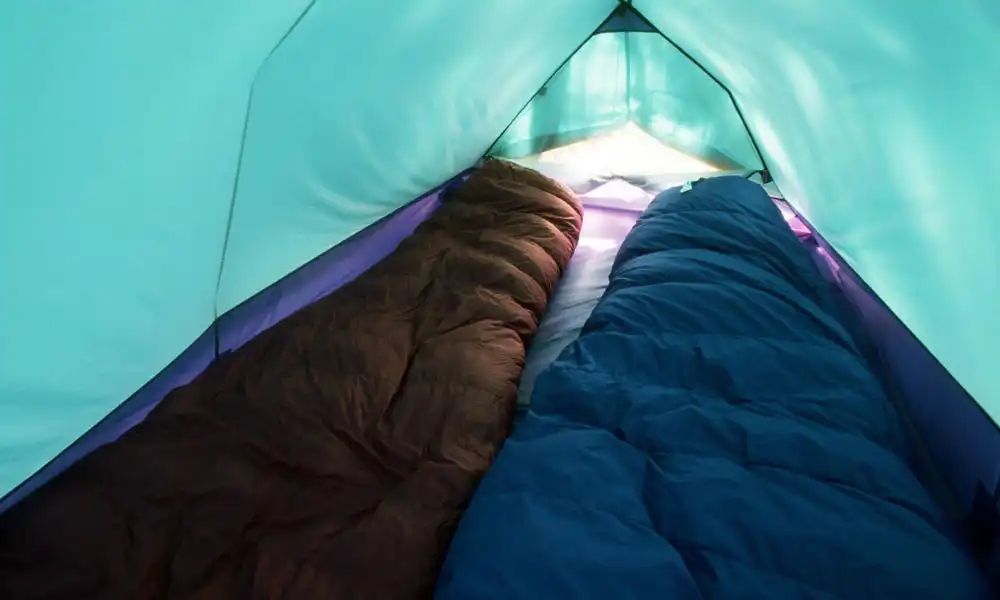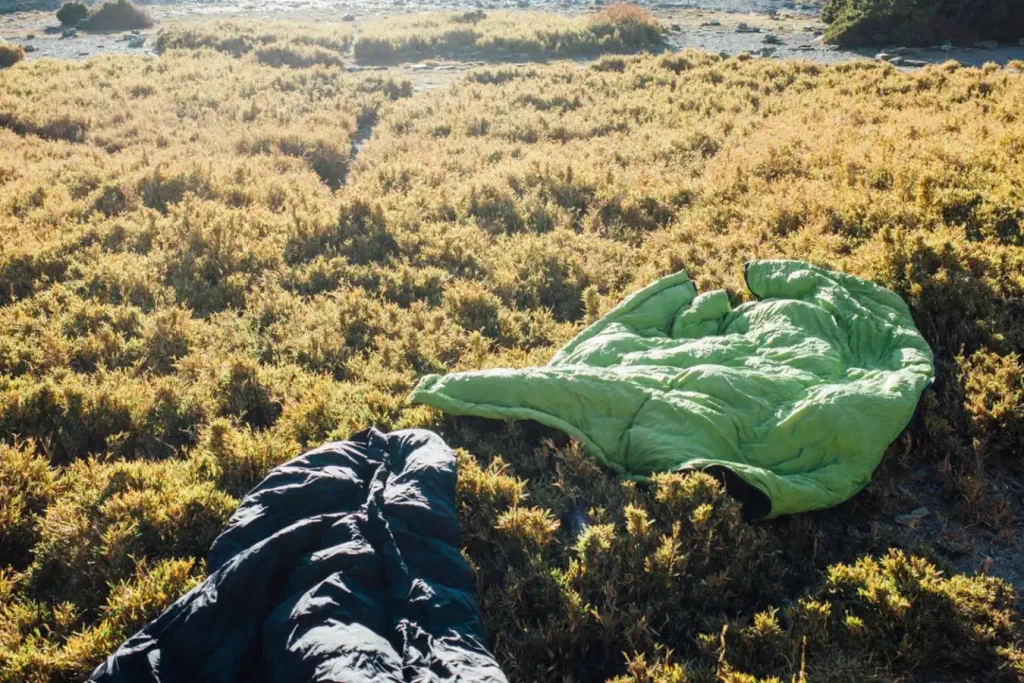“What to do if your down sleeping bag gets wet?” It’s the sinking feeling no camper wants to face.
Imagine: You’ve hiked all day, and now you’re greeted with a damp and droopy bed—ugh!
But don’t fret or let the dampness dampen your spirits.
With the right tricks up your sleeve, you can turn this soggy situation around.
Ready to become a wet-bag wizard? Let’s dive in!
The Characteristics of Down and Why It Matters
Before we dive into the nitty-gritty of drying your sleeping bag, it’s important to understand why down is commonly used in sleeping bags and how water affects it.
Explanation of the Composition and Benefits of Down
Down is the fluffy undercoat of ducks and geese, and it’s renowned for its superior insulation qualities. Its three-dimensional structure allows it to trap air and hold in body heat, making it perfect for keeping you warm on those cold camping nights. It’s also lighter and more compressible than other materials, making it the go-to choice for backpackers and hikers.
However, down isn’t without its challenges. Its Achilles’ heel? Water.
The Effect of Water on Down Filling
When down gets wet, the feathers clump together, losing their loft and, as a result, their insulating properties. Wet down also becomes heavy, making your sleeping bag a chore to carry around. In short, a wet down sleeping bag isn’t going to keep you warm or comfortable.
But before you start rethinking your gear, let me assure you that a wet down sleeping bag isn’t the end of the world. With some knowledge and a bit of patience, you can restore your sleeping bag back to its former glory.
The Risks of a Wet Down Sleeping Bag
A wet down sleeping bag doesn’t just mean an uncomfortable night’s sleep – it also comes with physical risks and potential damage to your beloved gear.
The Physical Risks: Weight Increase, Loss of Insulation, etc.
Water has a way of seeping into the down clusters and causing them to stick together, drastically reducing their insulating properties. This means your bag won’t be able to keep you warm, and a cold night in the wilderness is no joke. In addition, wet down becomes heavy. What was once an easy-to-carry sleeping bag now feels like a sack of bricks on your back.

The Potential for Damage and Reduced Lifespan
Constant wetting and drying can lead to degradation of the down itself, reducing its ability to loft and thereby insulate. Over time, this could lead to a significant decrease in the lifespan of your sleeping bag. Furthermore, when wet, the materials of your bag can become more susceptible to tearing, and the bag’s zippers and other parts can also suffer from damage.
Immediate Steps to Take When Your Down Sleeping Bag Gets Wet
Okay, we’ve painted a pretty dire picture, but don’t despair! If your down sleeping bag does get wet, there are steps you can take to mitigate the damage and possibly save your adventure.
Removing Excess Water
First things first, you’ll want to remove as much water from the bag as possible. Unzip the bag and turn it inside out to let the moisture escape more easily. If it’s just a small area that’s wet, pat it dry with a towel. Avoid wringing it out as this could damage the delicate down clusters and the bag’s fabric.
Choosing a Proper Drying Location
Next, find a suitable location for drying. Ideally, this would be a dry, sunny, and windy spot. Hang the bag out to dry in the open air. The sun’s warmth will aid in drying, while the breeze will help to loft the down back up. If you’re inside a tent, hang it as high as you can to take advantage of the warmer air at the top.

Ensuring Minimal Damage to the Sleeping Bag
Throughout the drying process, be gentle. Avoid exposing the bag to extreme heat sources like fires or heaters, as this can damage the fabric. Instead, opt for slow and gentle drying. Break up any clumps of down you can feel by massaging the bag, which will help restore loft and ensure an even dry. Patience is key here. It might take time, but it’s well worth it to keep your sleeping bag in top shape.
In short, If your down sleeping bag gets wet, promptly remove excess water, then clean if necessary using a gentle, down-specific detergent, and slowly dry it out completely to restore insulation and prevent mildew growth.
Cleaning a Wet Down Sleeping Bag
At some point, every down sleeping bag may require a good wash. Especially when it has gotten wet, proper cleaning can help protect the down and extend the lifespan of your bag.
When and Why Cleaning Is Necessary
Cleaning your down sleeping bag is necessary when dirt, oils, or other residue build up over time. These can affect the down’s ability to loft, impacting its insulating properties. Moreover, if your bag has gotten wet and has not dried properly, it may develop a mildewy smell. Cleaning can help eliminate these unwanted odors.
Steps for Safe Cleaning of a Down Sleeping Bag
Firstly, avoid washing your bag in a top-loading washing machine, as the agitator can damage the bag. Instead, use a front-loading washer. Use cold water and a gentle cycle.
Secondly, use a specialized down cleaner. Regular detergents can strip the down of its natural oils, which are crucial for its ability to insulate. Run an extra rinse cycle to ensure all the soap gets out.
Lastly, avoid twisting or wringing the bag. Carefully extract the excess water, and then gently press the bag to squeeze out more water.
Recommendations for Cleaning Products and Methods
There are a number of down-specific cleaners available, such as Nikwax Down Wash Direct or Granger’s Down Wash. These are specially formulated to clean without damaging the down or stripping its natural oils.
To know more: How Much Does a Sleeping Bag Weigh
Drying a Wet Down Sleeping Bag
Drying your down sleeping bag properly is just as important as the cleaning process.
Proper Methods for Drying Down
Air drying is the safest way to dry your bag, but it can take quite a long time, often more than a day. Alternatively, you can use a tumble dryer on the lowest heat setting. You can also add a few clean tennis balls to help break up the down clumps and maintain loft.
The Importance of a Slow and Careful Drying Process
A slow drying process helps protect the integrity of the down and the bag’s materials. High heat can damage the fabric and even melt it. A slower, gentler drying process allows the down clusters to regain their loft and ensures a thorough dry.
Tips for Maintaining the Loft During Drying
Shake out the bag periodically during the drying process to help separate the down clusters and maintain loft. Also, ensure that the bag is fully dry before storing it to prevent the growth of mildew.
Restoration of a Wet Down Sleeping Bag
Even with careful drying, the loft of your down sleeping bag might need a little boost. Let’s talk about how to restore it.
Steps to Restore Loft After the Bag Has Dried
Massage the bag gently to separate the down clusters and restore loft. You can also tumble the bag in a dryer on the “no heat” setting with a few clean tennis balls to help fluff it up.
Considerations for Professional Restoration Services
If your sleeping bag has been seriously waterlogged and you’re having trouble restoring it, you might want to consider professional restoration services. Professionals can wash, dry, and restore your bag with special equipment and techniques.
Your down sleeping bag is an investment, and with the right care, it can provide you with many years of warm and comfy sleep in the great outdoors.
Prevention Measures
Proper care can go a long way in ensuring your down sleeping bag stays dry and maintains its loft and insulating properties. Let’s discuss some measures you can take to prevent your bag from getting wet.
Tips for Keeping Your Down Sleeping Bag Dry During Camping Trips
When you’re out on a camping trip, keeping your sleeping bag dry can be a challenge, especially if the weather turns against you. Here are some tips to keep it dry:
- Use a waterproof stuff sack or a liner inside your pack to keep your sleeping bag dry during your hike.
- When setting up camp, choose a spot that’s well-drained and away from bodies of water.
- If it looks like rain is in the forecast, set up a tarp or some other form of overhead protection.
- Always air out your sleeping bag in the morning to prevent condensation buildup from the night’s use.
Appropriate Storage Methods to Prevent Moisture Buildup
When not in use, store your sleeping bag in a cool, dry place. Avoid storing it compressed in a stuff sack for long periods. Instead, use a larger, breathable storage sack to let the down loft and to prevent moisture buildup.
Expert Insights
There’s nothing like first-hand knowledge, so let’s take a look at some advice from experienced campers and outdoor enthusiasts.
Advice from Experienced Campers and Outdoor Enthusiasts
One tip that many seasoned campers suggest is using a sleeping bag liner. Not only does it add a layer of warmth, but it also helps protect the inner part of the bag from dirt, sweat, and accidental spills.
Another tip is to always have a backup plan. This could mean packing an emergency blanket or having additional clothing layers to keep you warm in case your sleeping bag gets wet.
Recommendations for the Best Down Sleeping Bags Resistant to Moisture
Several sleeping bag brands offer models with hydrophobic down, which is treated to resist water. Examples include the Marmot Hydrogen, the Mountain Hardwear Phantom Spark, and the Sea to Summit Ascent AcII. These bags can provide a little extra peace of mind when camping in wet conditions.
FAQs about Down Sleeping Bag Gets Wet
How Do You Fix a Wet Down Sleeping Bag?
What Happens if Down Sleeping Bag Gets Wet?
Can You Dry a Down Sleeping Bag?
How Long Does It Take to Dry a Down Sleeping Bag?
Final Words
Keeping a down sleeping bag dry is vital to preserving its warmth, loft, and longevity. If your bag does get wet, remember to remove excess water, choose a proper drying location, and ensure minimal damage. Cleaning, drying, and restoring a wet down sleeping bag requires patience, but doing so correctly can extend its lifespan and ensure you get the most out of your investment.
Down sleeping bags are an essential part of your camping gear, offering unmatched warmth-to-weight ratio and compactness. With the right care, they can serve you well for many adventures. So, whether you’re a seasoned camper or a beginner, understanding how to handle and maintain your down sleeping bag when it gets wet is a skill worth having.
Here’s to many more cozy nights under the stars!


